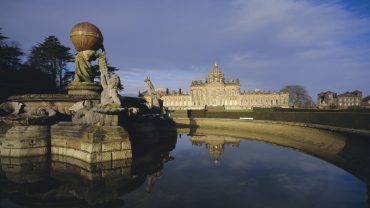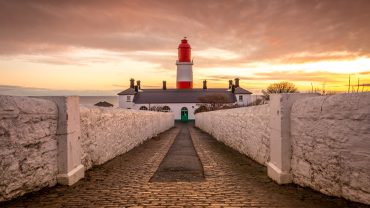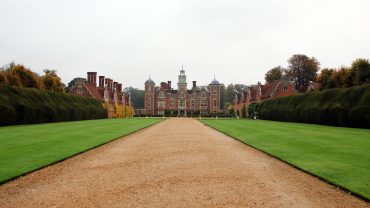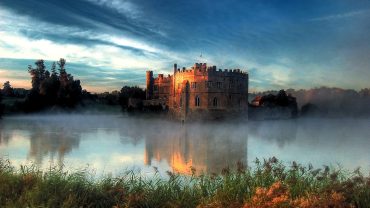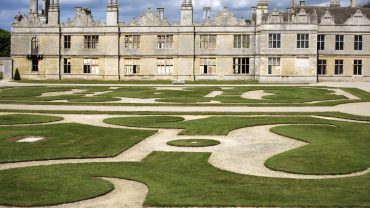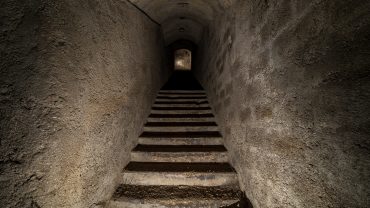Soaring battlements, impenetrable curtain walls and commanding hilltop positions not only speak to a tumultuous past of local rivalries and foreign invasions, but also to a rich heritage of Scottish castle architecture which blends functionality and necessity with aesthetic ambition.
From the iconic silhouette of Edinburgh Castle on top of Castle Rock to the dramatic cliff-top ruins of Dunnottar, each of these legendary Scottish castles tells a story of how builders harnessed local stone, terrain, and evolving defensive strategies to create structures that have become emblems of Scotland itself.
This time trip back in history will tell the dramatic tale of the design of Scottish castles.
The Origins of Castles in Scotland

Duffus Castle, one of the earliest motte and bailey castles in Scotland (Credit: Tom McPherson via Getty Images)
The beginnings of Scottish castle architecture trace back to the reign of King David I in the twelfth century, coinciding with the introduction of feudalism and the arrival of Norman and French nobles.
When he was crowned King of Scotland in 1124, David introduced the Norman practice of castle building to Scotland, inviting Norman and French noblemen to his court and encouraging them to build castles – in return for land – as a means of both consolidating royal authority and defending the kingdom. These early castles, typically of the motte-and-bailey type, were constructed from wood and earth, featuring a keep on top of a raised mound (the motte) and an enclosed courtyard (the bailey) surrounded by a defensive fence or ditch.
This marked a significant shift in Scottish castle architecture and feudal organisation, as castles became centres of local power and administration.
The introduction of Scottish castles under David I fundamentally transformed Scottish society, helping to establish feudalism and providing a network of strongholds that could be used to control rebellious regions, especially in the north. The castles also facilitated the spread of Norman culture and administrative practices, laying the groundwork for further architectural developments in the design of Scottish castles in later centuries.
Scottish Castle Architecture in the Middle Ages

Eilean Donan, the most picturesque of all Scottish castles from the Middle Ages (Credit: paulmerrett via Getty Images)
As the need for more permanent and formidable defences grew, these wooden fortresses were gradually replaced by stone castles with high curtain walls, exemplified by early royal fortifications at Ayr and Berwick. The evolution of Scottish castle architecture was not only a response to military threats but also a reflection of the growing administrative and residential needs of the Scottish nobility and monarchy.
Throughout the Middle Ages, the design of Scottish castles evolved in response to changing warfare and social structures. The Wars of Independence in the late thirteenth and early fourteenth centuries saw a shift in strategy, with Robert the Bruce famously ordering the destruction – or slighting – of castles (including those at Stirling, Roxburgh and Edinburgh) to prevent their capture by English forces.
The Introduction of Gunpowder

Blackness Castle near Edinburgh on the Firth of Forth (Credit: jgshields via Getty Images)
The introduction of gunpowder weaponry in the fifteenth century was another defining evolution in Scottish castle history, prompting innovations such as keyhole gun ports and D-shaped bastions, like those at the now ruined Ravenscraig Castle, one of the first in the UK designed to withstand artillery bombardment. The fortress of Craignethan, with its angled walls, was also designed to deflect cannon fire.
Castles such as Tantallon – the last medieval curtain wall castle in Scotland – and Blackness, originally built in the 1440s, were rebuilt on a grander scale to house large garrisons, reflecting the dual military and residential functions these structures served. Indeed, Blackness became a garrison site in the mid-sixteenth century and remained so for well over three hundred years. It was even used briefly during World War I.
Tower Houses

Smailholm Tower, just west of Kelso in the Scottish Borders (Credit: Jim MacRae via Getty Images)
A distinctive feature of Scottish castle architecture is the proliferation of tower houses from the late Middle Ages. These tall, stone-built structures – of which there are around 800 in total – including Scotstarvit Tower in Fife, and Claypotts Castle in Dundee, were primarily designed to offer protection against local raiding parties rather than withstand full-scale sieges. Smaller variants were common along the Anglo-Scottish border. Notable examples include Smailholm Tower in the Scottish Borders, and Darnick Tower, a few miles from Melrose. Most incorporated a byre for animals on the ground floor, and living space, reached by a removable ladder, on the upper floor.
The Renaissance

The imposing ruins of Linlithgow Palace (Credit: BMPix via Getty Images)
Meanwhile, the roles of Scottish castles broadened beyond purely martial functions. Great halls expanded, domestic quarters became more comfortable, and decorative elements such as heraldic carvings and painted ceilings began to announce noble status as loudly as any battlement.
The Renaissance brought a new wave of Scottish castle architecture, with Linlithgow and Falkland Palace standing out for their blend of defensive features and European elegance, the latter inspired by French châteaux and favoured by the Stuart monarchs. They incorporated grand courtyards, mullioned windows, and steeply pitched roofs, transforming the medieval fortress into a setting for courtly life and royal pageantry.
The Scots Baronial Style

Crathes, a sixteenth century castle in Aberdeenshire (Credit: Elnur via Getty Images)
The sixteenth and seventeenth centuries witnessed a transition from purely defensive castles to more comfortable and stylish estate houses as political stability grew. The Scots Baronial style emerged during this period, characterised by features such as crow-stepped gables, turrets, and battlements, which harkened back to medieval fortifications at the start of the story of Scottish castle history, while prioritising domestic comfort.
Castles such as Colliston adopted the Z-plan layout, combining grandeur with practicality. The interiors evolved as well, with a focus on privacy and leisure, as seen in the sequential arrangement of rooms and the inclusion of galleries for family recreation.
Stirling Castle, extensively remodelled under James V, flaunted Italianate loggias and oriel windows, while nearby Castle Campbell (formerly called Castle Gloom) introduced terraced gardens and refined stonework which hinted at continental trends.
Built starting in 1553 and completed by the early seventeenth century, Crathes Castle is a perfect example of the transition from purely defensive tower houses to more comfortable and stylistically elaborate residences. It features characteristic Scots Baronial elements such as bartizans (corner turrets) with conical roofs and decorative stonework, reflecting the shift toward domestic comfort and aesthetic appeal while retaining some defensive features. Crathes also showcases the evolution of interior design with private spaces and galleries, making it a prime example of a late sixteenth century Scottish castle.
Scottish Castle Architecture in the Eighteenth Century & Beyond

Culzean Castle, perhaps the finest Scottish example of Georgian architecture (Credit: DouglasMcGilviray via Getty Images)
By the eighteenth century, the military significance of castles had faded, but their romantic appeal endured.
The Gothic Revival of the late eighteenth and nineteenth centuries saw a resurgence of the design of Scottish castles, epitomised by Inveraray Castle and the remodelling of Culzean Castle by Robert Adam. The rebuilding of Balmoral Castle as a royal residence for Queen Victoria cemented the popularity of the Scots Baronial style, influencing both grand estates and more modest homes.
Today, many of these Scottish castles are preserved and safeguarded as national treasures by organisations including Historic Environment Scotland, captivating visitors with their blend of history, artistry, and Scottish tradition.



